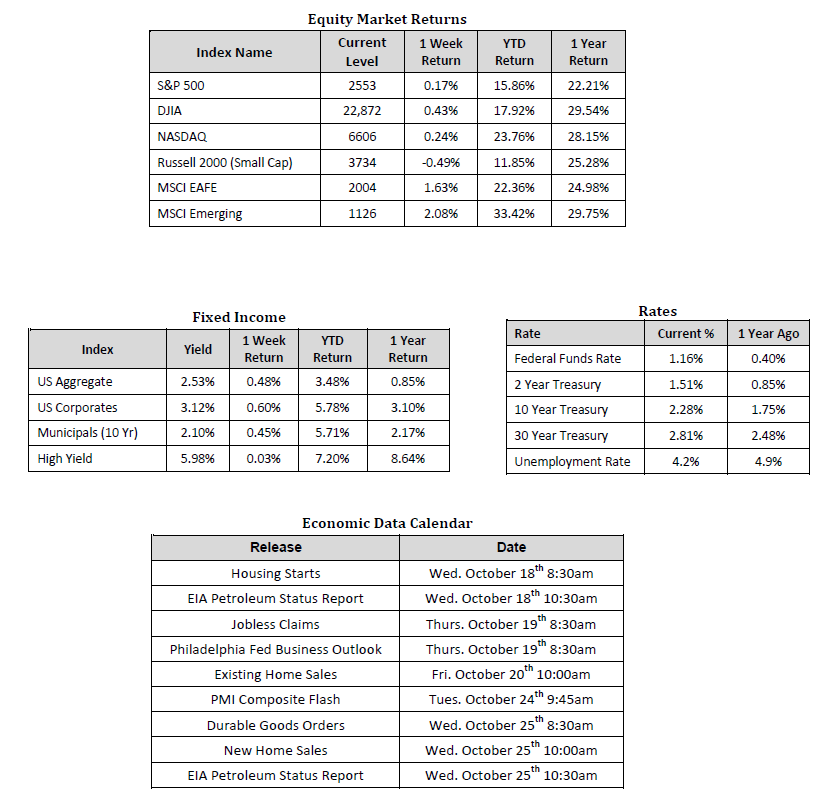
Fourth Quarter Earnings Season Underway
Market Overview
Sources: Sources for data in tables: Equity Market and Fixed Income returns are from JP Morgan as of 10/13/17. Rates and Economic Calendar Data from Bloomberg as of 10/16/17. International developed markets measured by the MSCI EAFE Index, emerging markets measured by the MSCI EM Index. Sector performance is measured using GICS methodology.
Happening Now
U.S. Stocks gained again last week with the S&P 500 Index moving 0.2% higher to close at 2,553 on Friday. The Russell Midcap Index also gained 0.2% last week while small cap stocks, as represented by the Russell 2000 Index, fell 0.5%. This is the first time in four weeks that small cap stocks have fallen in value and represents a break from the out-performance smaller firms have experienced over this time frame. Internationally, developed markets gained 1.6% while emerging markets advanced 2.1% for the week.
The S&P 500 Index is used as a broad proxy for U.S. equities and is now up nearly 16% since the start of 2017- significantly higher than nearly all analyst estimates at the beginning of the year. As we mentioned in our note last week, we find it encouraging that much of this year’s gain can be attributed to fundamental growth companies have experienced in aggregate. In other words, U.S. stocks have not been pushed up solely by speculators hoping for future growth but rather, they have grown their sales and earnings to justify today’s higher prices.
Earnings season is our quarterly opportunity to look under the hood at a company’s financial statements. While earnings grew at a double digit pace during the second quarter, it is estimated that third quarter earnings growth will come in only around 2%. This lower level of growth is in part attributed to the series of hurricanes that hit the southern part of the United States in August as well as tighter corporate profit margins. Looking ahead to the fourth quarter, earnings are expected to return to a double digit pace in the U.S. but we believe it may be worth considering international stocks for the relatively strong growth prospects they present.
The economic landscape continues to be constructive for stocks. Financial conditions are loose, economic activity continues to move higher, sentiment is strong, the labor market remains tight, and wage growth is slowly ticking higher. Further, the lack of inflation has allowed the Federal Reserve to maintain their gradual path of rate hikes creating a “goldi-locks” scenario of economic growth with low inflation and low interest rates. We believe that investors should be capturing the growth potential of today’s stock market but stress that it must be done in a manner where, during the next sell-off, the investor feels little pressure to sell. In order to accomplish this, a portfolio must be constructed with not only an appreciation for what is attractive today but also an understanding of how the strategy will perform during an adverse market environment.
Important Information and Disclaimers
Disclosures: Hennion & Walsh is the sponsor of SmartTrust® Unit Investment Trusts (UITs). For more information on SmartTrust® UITs, please visit www.smarttrustuit.com. The overview above is for informational purposes and is not an offer to sell or a solicitation of an offer to buy any SmartTrust® UITs. Investors should consider the Trust’s investment objective, risks, charges and expenses carefully before investing. The prospectus contains this and other information relevant to an investment in the Trust and investors should read the prospectus carefully before they invest.
Investing in foreign securities presents certain risks not associated with domestic investments, such as currency fluctuation, political and economic instability, and different accounting standards. This may result in greater share price volatility. These risks are heightened in emerging markets.
There are special risks associated with an investment in real estate, including credit risk, interest rate fluctuations and the impact of varied economic conditions. Distributions from REIT investments are taxed at the owner’s tax bracket.
The prices of small company and mid cap stocks are generally more volatile than large company stocks. They often involve higher risks because smaller companies may lack the management expertise, financial resources, product diversification and competitive strengths to endure adverse economic conditions.
Investing in commodities is not suitable for all investors. Exposure to the commodities markets may subject an investment to greater share price volatility than an investment in traditional equity or debt securities. Investments in commodities may be affected by changes in overall market movements, commodity index volatility, changes in interest rates or factors affecting a particular industry or commodity.
Products that invest in commodities may employ more complex strategies which may expose investors to additional risks.
Investing in fixed income securities involves certain risks such as market risk if sold prior to maturity and credit risk especially if investing in high yield bonds, which have lower ratings and are subject to greater volatility. All fixed income investments may be worth less than original cost upon redemption or maturity. Bond Prices fluctuate inversely to changes in interest rates. Therefore, a general rise in interest rates can result in the decline of the value of your investment.
Definitions
MSCI- EAFE: The Morgan Stanley Capital International Europe, Australasia and Far East Index, a free float-adjusted market capitalization index that is designed to measure developed-market equity performance, excluding the United States and Canada.
MSCI-Emerging Markets: The Morgan Stanley Capital International Emerging Market Index, is a free float-adjusted market capitalization index that is designed to measure the performance of global emerging markets of about 25 emerging economies.
Russell 3000: The Russell 3000 measures the performance of the 3000 largest US companies based on total market capitalization and represents about 98% of the investible US Equity market.
ML BOFA US Corp Mstr [Merill Lynch US Corporate Master]: The Merrill Lynch Corporate Master Market Index is a statistical composite tracking the performance of the entire US corporate bond market over time.
ML Muni Master [Merill Lynch US Corporate Master]: The Merrill Lynch Municipal Bond Master Index is a broad measure of the municipal fixed income market.
Investors cannot directly purchase any index.
LIBOR, London Interbank Offered Rate, is the rate of interest at which banks offer to lend money to one another in the wholesale money markets in London.
The Dow Jones Industrial Average is an unweighted index of 30 “blue-chip” industrial U.S. stocks.
The S&P Midcap 400 Index is a capitalization-weighted index measuring the performance of the mid-range sector of the U.S. stock market, and represents approximately 7% of the total market value of U.S. equities. Companies in the Index fall between S&P 500 Index and the S&P SmallCap 600 Index in size: between $1-4 billion.
DJ Equity REIT Index represents all publicly traded real estate investment trusts in the Dow Jones U.S. stock universe classified as Equity REITs according to the S&P Dow Jones Indices REIT Industry Classification Hierarchy. These companies are REITSs that primarily own and operate income-producing real estate.




